After some close calls when testing cattle, Colin Tyner from Shilleagh, Co Wicklow, decided to build a state-of-the-art cattle handling unit to make handling his 100-cow suckler herd safer and more efficient.
Design details
The handling unit is made up of three large holding pens, which allows high numbers of stock to be held close to the race, allowing for efficient throughput of cattle for handling
A semicircular carousel with a diameter of 7.6m is used to drive cattle into the race. The carousel is fitted with an anti-backing gate to ensure operator safety when trying to push cattle towards the race mouth.
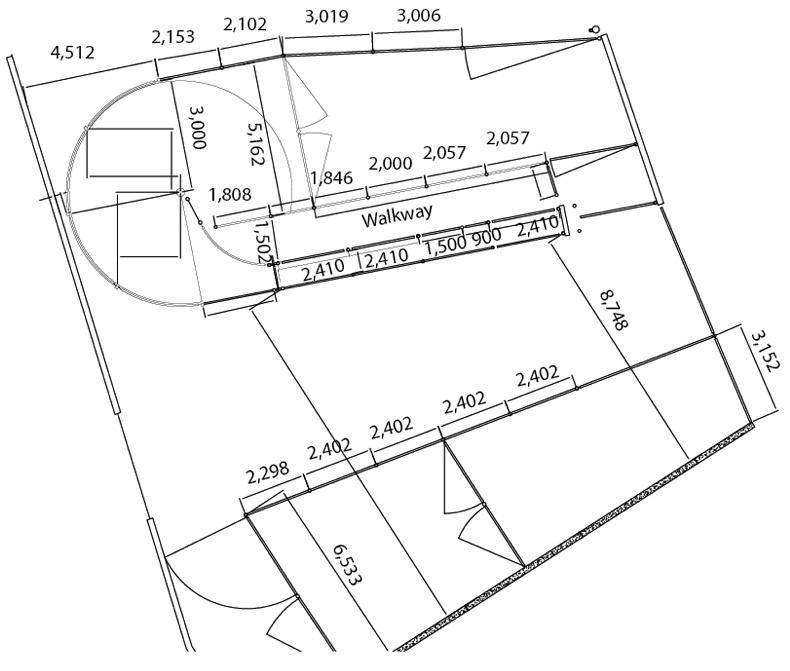
A large suckler herd of more than 100 continental cows, with all progeny brought through to slaughter, is currently run on the farm.
Up to 150 cattle can be easily held in the yard for handling at any one time. This greatly reduces the time taken to carry out any jobs such as dosing or injecting, as all cattle can be assembled beforehand. The race itself is 9.6m long and can hold approximately five cows at a time.
The handling unit is designed so that cattle are continually moving in a U shape between holding areas and the race itself. This is because cattle have a tendency to return in the direction from which they came.
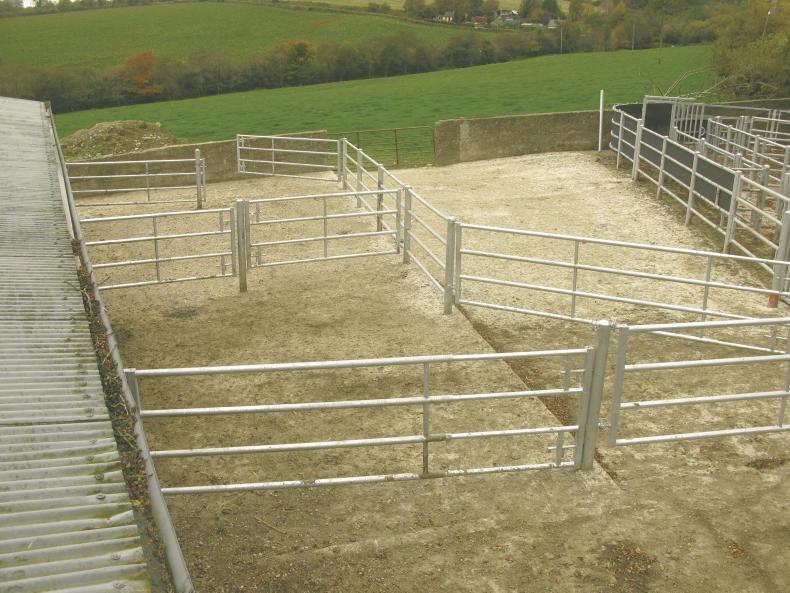
There are a total of three large holding pens that can hold approximately 150 cattle.There are a total of three large holding pens that can hold approximately 150 cattle.
The holding pens are designed to be relatively narrow to ensure that cattle will naturally move forwards and so that they do not have sufficient space to turn back on the farmer.
The carousel is fitted with notches along the top bar to prevent the gate from swinging back if an animal pushes against it, ensuring the safety of the farmer. The curved entrance to the race is lined with stock board. This is done so that cattle don’t get distracted or startled by activity around the race.
All of the concrete in the yard was grooved when it was laid to ensure cattle would not slip and injure themselves or others.

A passageway alongside the crush means that farmers can carry out work on cattle safely.A passageway alongside the crush means that farmers can carry out work on cattle safely.
Costs
All the steelwork and the plans for the handling unit were provided by Condon Engineering and cost a total of €9,560 including VAT. The concrete cost a total of €6,750 including VAT while total labour costs accumulated to €4,500 including VAT. This gives a total cost of €20,810 including VAT.
Colin hopes to claim approximately €5,000 back through VAT, leaving a total cost of the handling unit at approximately €15,810. Colin did not apply for a TAMS grant on the project.

This simple handling unit would be the ideal setup for many outfarms, with a total cost of €7,000 excluding VAT.This simple handling unit would be the ideal setup for many outfarms, with a total cost of €7,000 excluding VAT.
This cattle crush and adjoining yard can comfortably hold about 40 cattle. Gates break up the yard into three individual holding pens, which gives great freedom when testing or handling cattle in different groups. Gearoid Booth, a farmer from The Heath, Co Laois, built this unit on his farm.

Design details
The extendable gates can be set up to have a minimum span of 3m and be expanded to a maximum of 4m, as well as being extremely heavy duty for dealing for larger cattle.
Slip-through escapes are located in a number of places around the yard, allowing greater and safer access in and out of pens without having to open or close gates.
Extendable gates were hung as part of the perimeter fencing of some pens. Having multiple access points on the outside of the yard means cattle in each pen can be moved out easily without upsetting cattle being held in other pens.
The forcing gate behind the crush is probably the best aspect of the facility. It makes the job of getting cattle into the crush very easy and safe.
A latch at the top of the forcing gate allows it to be held in a number of positions as it is swung around, constantly moving the cattle forward towards the crush. It means the person pushing the forcing gate forward is never in the line of fire. when cattle kick-back at the gate.

A guillotine gate is fitted to the back of the race.A guillotine gate is fitted to the back of the race.
Another well thought-out safety measure at the entrance of the crush is the sliding gate. The sliding mechanism reduces all risk of cattle kicking back at you as it can easily be opened and closed from the far side of the crush rather than directly from behind, as is usually the case.
The crush can hold seven cattle (450kg to 500kg) at a time.
There is a semi semi-automatic headgate at the front of the crush at a cost of €280 excl. VAT.
There is also an elevated concrete platform on the outside of the crush to make handling cattle in the crush easier. This platform is outside the holding pens, which means anyone using the crush can carry out their work in safety.
With attractive grants available under TAMS II, many farmers are looking at handling units as an investment.
Outside blocks of land on livestock farms usually need handling facilities suitable for a number of different jobs.
The facilities need to be capable of simplifying and creating a safe environment for tasks such as the annual cattle test, summer dosing, AI service, scanning and of course a place to gather and load cattle prior to moving stock home for the winter or selling them straight off the land.
A well-designed facility can speed up work and help to reduce the safety risks that are associated with handling livestock.
The drawing shows a cattle crush and holding pens suitable for all these tasks.
These facilities make the everyday cattle handling tasks quick and easy with minimal need for extra help.
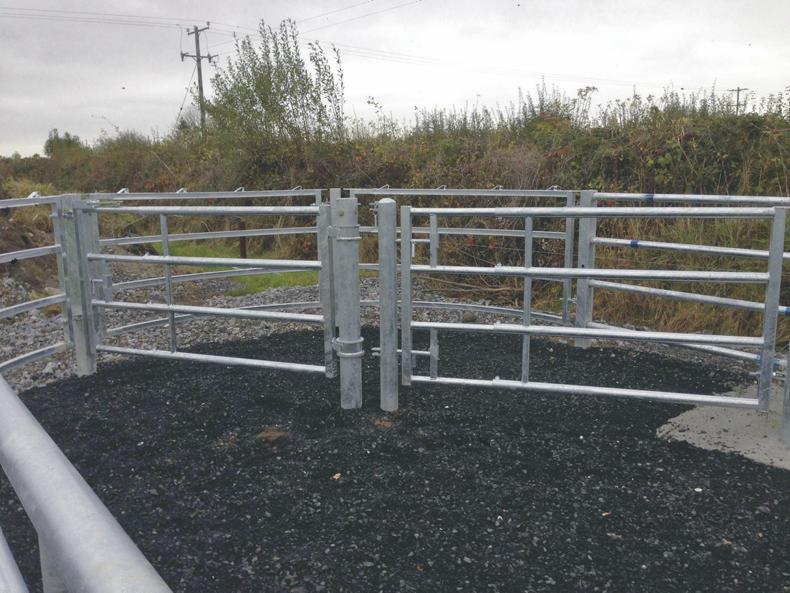
Circular forcing pens ensure cattle can be safely moved to the mouth of the race.Circular forcing pens ensure cattle can be safely moved to the mouth of the race.
Costs
A project like this would cost around €7,000, excluding vat, which covers all concrete (about 13m3), machinery work and steel.
This article first appeared in the Irish Farmers Journal Farm Buildings magazine.
After some close calls when testing cattle, Colin Tyner from Shilleagh, Co Wicklow, decided to build a state-of-the-art cattle handling unit to make handling his 100-cow suckler herd safer and more efficient.
Design details
The handling unit is made up of three large holding pens, which allows high numbers of stock to be held close to the race, allowing for efficient throughput of cattle for handling
A semicircular carousel with a diameter of 7.6m is used to drive cattle into the race. The carousel is fitted with an anti-backing gate to ensure operator safety when trying to push cattle towards the race mouth.

A large suckler herd of more than 100 continental cows, with all progeny brought through to slaughter, is currently run on the farm.
Up to 150 cattle can be easily held in the yard for handling at any one time. This greatly reduces the time taken to carry out any jobs such as dosing or injecting, as all cattle can be assembled beforehand. The race itself is 9.6m long and can hold approximately five cows at a time.
The handling unit is designed so that cattle are continually moving in a U shape between holding areas and the race itself. This is because cattle have a tendency to return in the direction from which they came.

There are a total of three large holding pens that can hold approximately 150 cattle.There are a total of three large holding pens that can hold approximately 150 cattle.
The holding pens are designed to be relatively narrow to ensure that cattle will naturally move forwards and so that they do not have sufficient space to turn back on the farmer.
The carousel is fitted with notches along the top bar to prevent the gate from swinging back if an animal pushes against it, ensuring the safety of the farmer. The curved entrance to the race is lined with stock board. This is done so that cattle don’t get distracted or startled by activity around the race.
All of the concrete in the yard was grooved when it was laid to ensure cattle would not slip and injure themselves or others.

A passageway alongside the crush means that farmers can carry out work on cattle safely.A passageway alongside the crush means that farmers can carry out work on cattle safely.
Costs
All the steelwork and the plans for the handling unit were provided by Condon Engineering and cost a total of €9,560 including VAT. The concrete cost a total of €6,750 including VAT while total labour costs accumulated to €4,500 including VAT. This gives a total cost of €20,810 including VAT.
Colin hopes to claim approximately €5,000 back through VAT, leaving a total cost of the handling unit at approximately €15,810. Colin did not apply for a TAMS grant on the project.

This simple handling unit would be the ideal setup for many outfarms, with a total cost of €7,000 excluding VAT.This simple handling unit would be the ideal setup for many outfarms, with a total cost of €7,000 excluding VAT.
This cattle crush and adjoining yard can comfortably hold about 40 cattle. Gates break up the yard into three individual holding pens, which gives great freedom when testing or handling cattle in different groups. Gearoid Booth, a farmer from The Heath, Co Laois, built this unit on his farm.

Design details
The extendable gates can be set up to have a minimum span of 3m and be expanded to a maximum of 4m, as well as being extremely heavy duty for dealing for larger cattle.
Slip-through escapes are located in a number of places around the yard, allowing greater and safer access in and out of pens without having to open or close gates.
Extendable gates were hung as part of the perimeter fencing of some pens. Having multiple access points on the outside of the yard means cattle in each pen can be moved out easily without upsetting cattle being held in other pens.
The forcing gate behind the crush is probably the best aspect of the facility. It makes the job of getting cattle into the crush very easy and safe.
A latch at the top of the forcing gate allows it to be held in a number of positions as it is swung around, constantly moving the cattle forward towards the crush. It means the person pushing the forcing gate forward is never in the line of fire. when cattle kick-back at the gate.

A guillotine gate is fitted to the back of the race.A guillotine gate is fitted to the back of the race.
Another well thought-out safety measure at the entrance of the crush is the sliding gate. The sliding mechanism reduces all risk of cattle kicking back at you as it can easily be opened and closed from the far side of the crush rather than directly from behind, as is usually the case.
The crush can hold seven cattle (450kg to 500kg) at a time.
There is a semi semi-automatic headgate at the front of the crush at a cost of €280 excl. VAT.
There is also an elevated concrete platform on the outside of the crush to make handling cattle in the crush easier. This platform is outside the holding pens, which means anyone using the crush can carry out their work in safety.
With attractive grants available under TAMS II, many farmers are looking at handling units as an investment.
Outside blocks of land on livestock farms usually need handling facilities suitable for a number of different jobs.
The facilities need to be capable of simplifying and creating a safe environment for tasks such as the annual cattle test, summer dosing, AI service, scanning and of course a place to gather and load cattle prior to moving stock home for the winter or selling them straight off the land.
A well-designed facility can speed up work and help to reduce the safety risks that are associated with handling livestock.
The drawing shows a cattle crush and holding pens suitable for all these tasks.
These facilities make the everyday cattle handling tasks quick and easy with minimal need for extra help.

Circular forcing pens ensure cattle can be safely moved to the mouth of the race.Circular forcing pens ensure cattle can be safely moved to the mouth of the race.
Costs
A project like this would cost around €7,000, excluding vat, which covers all concrete (about 13m3), machinery work and steel.
This article first appeared in the Irish Farmers Journal Farm Buildings magazine. 












 This is a subscriber-only article
This is a subscriber-only article




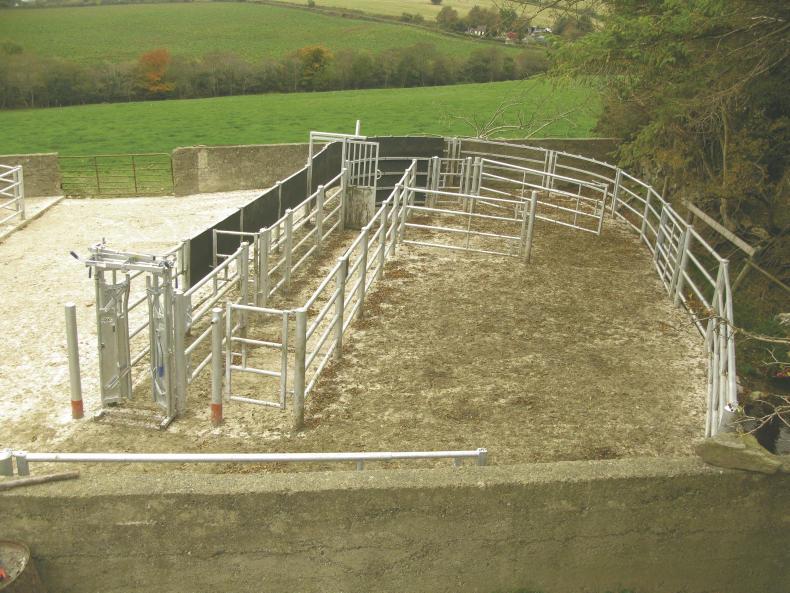

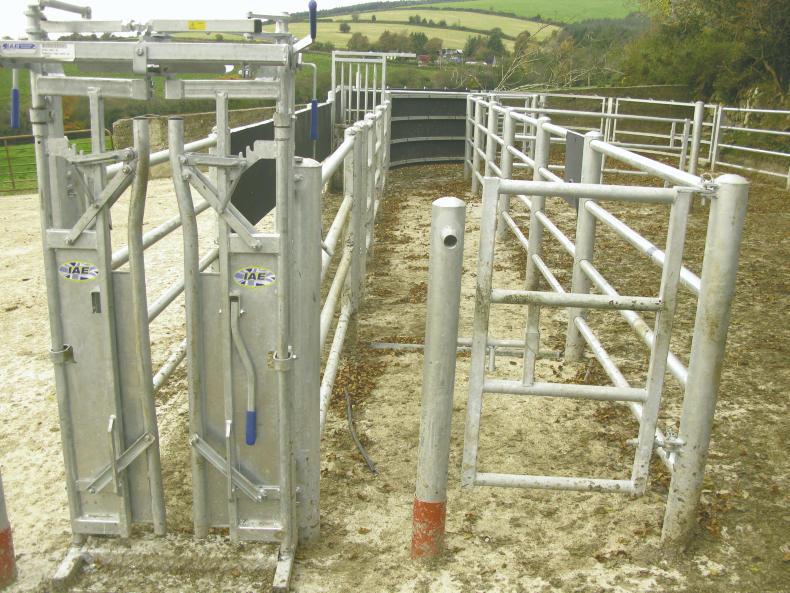
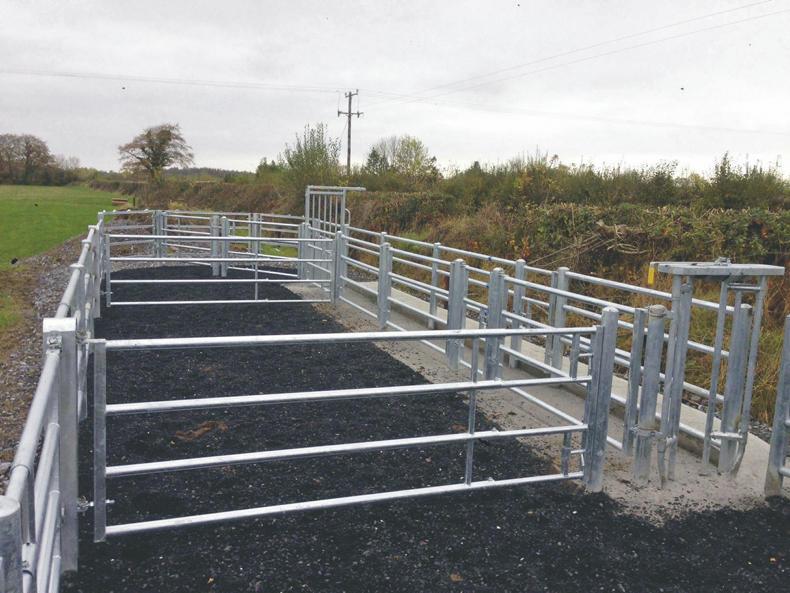
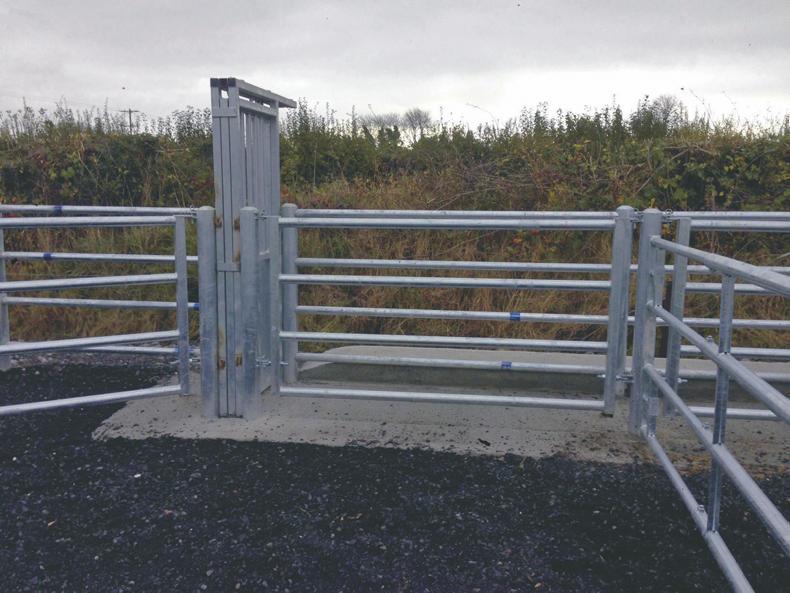





SHARING OPTIONS: